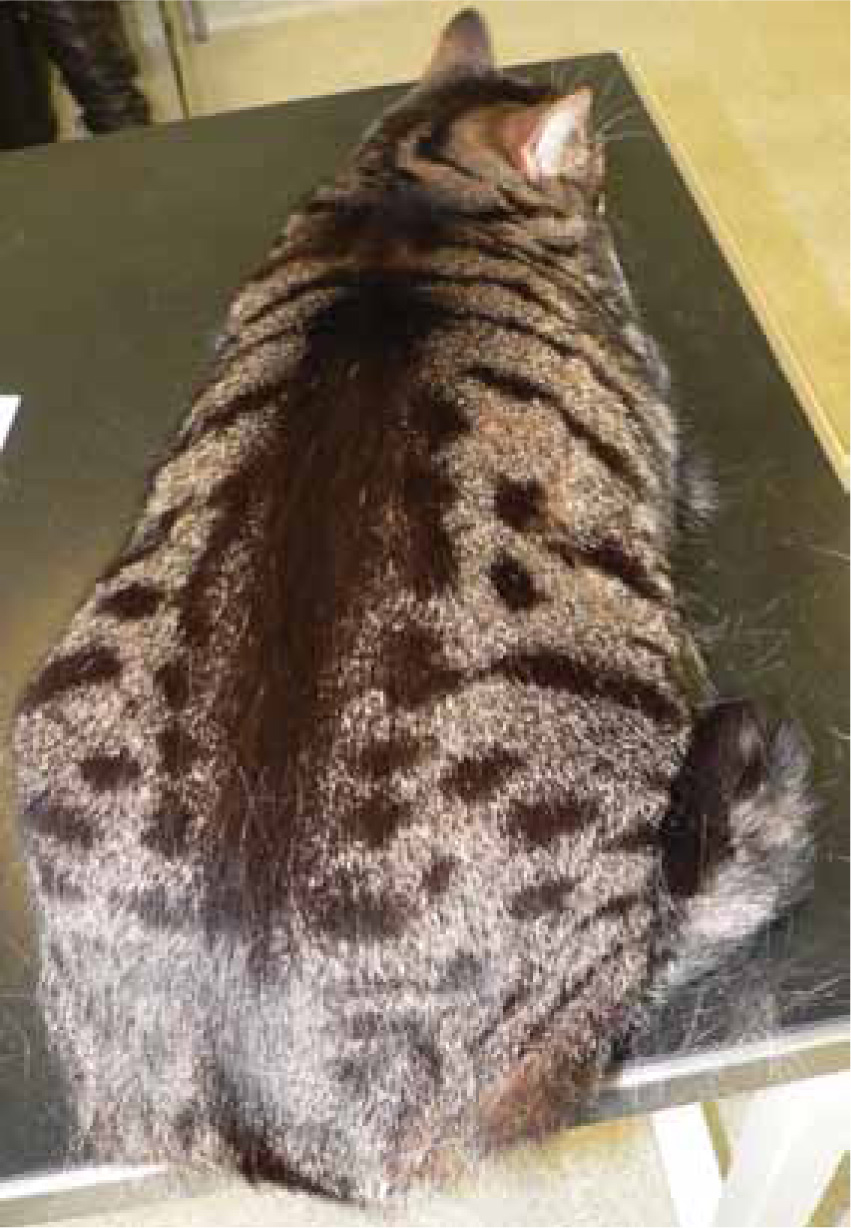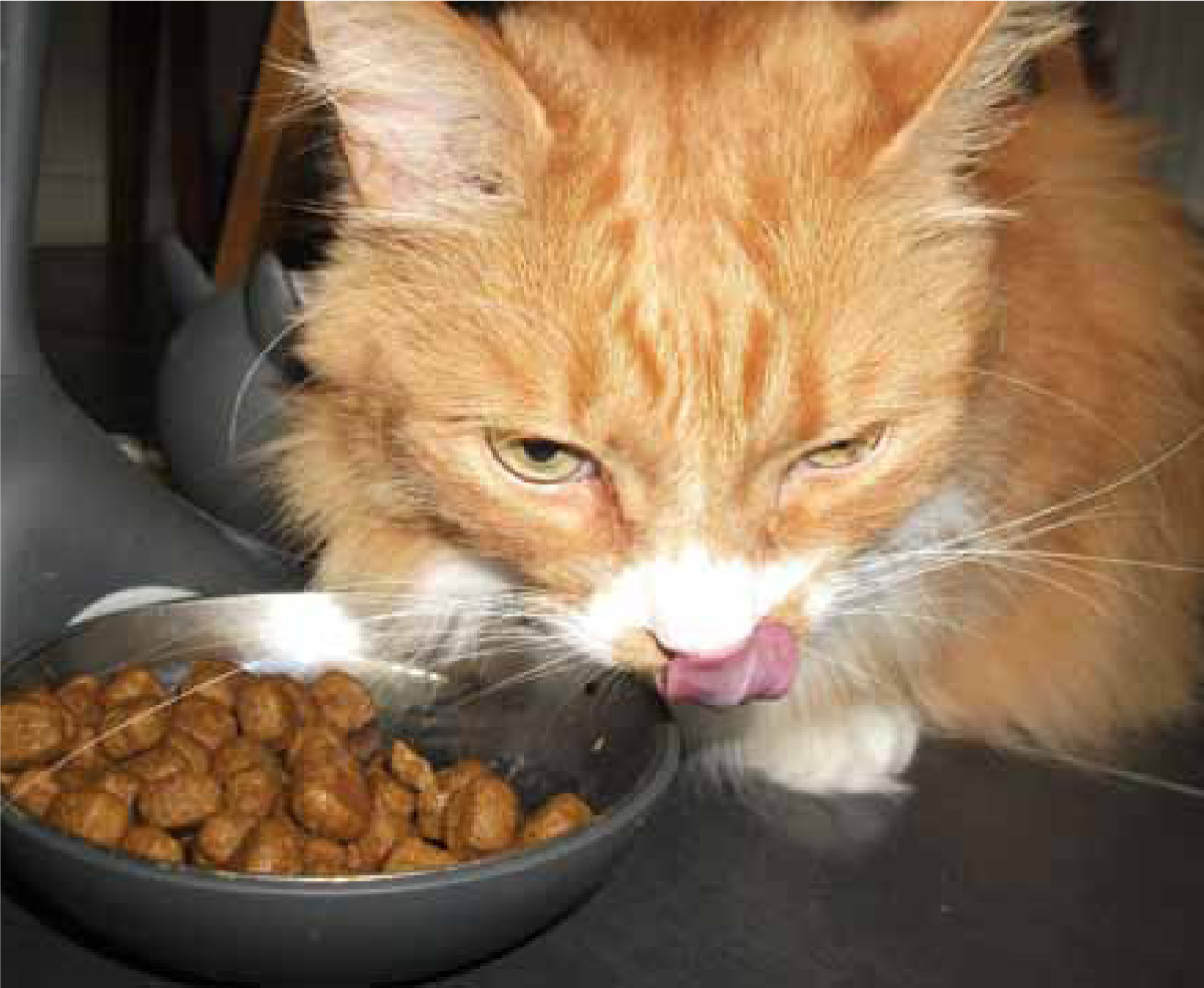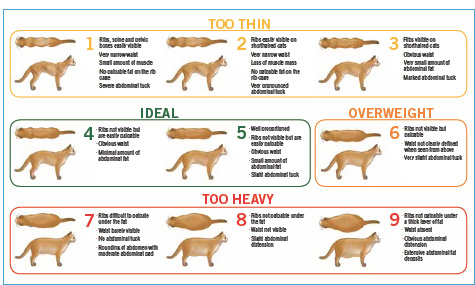Diabetes mellitus is a common but serious condition in cats resulting from an absolute or relative insulin deficiency. The majority of diabetic dogs are suffering from an absolute insulin deficiency caused by destruction of the pancreatic beta cells. In contrast, cats are more likely to have a relative insulin deficiency, resulting from insulin resistance, usually caused by obesity (Figure 1). Over time though, these cats can develop an absolute insulin deficiency as a result of progressive disruption of normal beta cell function.

Regardless of the aetiology, insufficient insulin action results in a persistent hyperglycaemia. As blood glucose levels exceed the renal threshold, glucose is lost in the urine causing an osmotic polyuria and compensatory polydipsia. At the same time, the majority of body cells are less able to take up glucose, amino acids and fatty acids and convert them to their storage forms, resulting in polyphagia and weight loss. Other symptoms frequently contribute to the clinical picture including short- and long-term complications such as diabetic ketoacidosis and diabetic neuropathy.
Medical treatment with insulin remains the cornerstone of therapy, and although insulin resistance in overweight diabetic cats may be reversed with weight loss (Biourge et al, 1997), it is important to still treat promptly with insulin. Any complicating factors will need to be resolved, for example by treating concurrent conditions such as urinary tract infections, and ceasing steroid treatments if possible. Nutritional management is also an important factor to consider, because diet characteristics and feeding practices inevitably influence glucose absorption and, therefore, insulin therapy. Knowledge in this area has evolved significantly during the last decade.
Principles of nutritional management
It should be noted that if there are concurrent conditions which influence nutritional needs these will usually take precedence, for example concurrent renal disease (Rand and Marshall, 2005).
It is the composition of the diet rather than the presentation (wet versus dry) that is the key factor in helping to nutritionally support cats with diabetes. Whatever diet is fed, the most important aspect of nutritional management is consistency. In order to determine the required insulin dose and predict a repeatable daily response, a consistent diet, ration and meal schedule should be rigorously observed. Selecting a diet that has a fixed formula will also help to maintain consistency as there will be no changes in ingredients or formulation from batch to batch.
Diabetic cats can be managed in the same way as dogs; being fed twice daily at set mealtimes, but more frequent, smaller meals or graze-feeding with free access to the daily ration can help maintain a more stable glycaemic level (Lutz, 2008) and is more in line with the cat's natural feeding pattern. For overweight cats or cats prone to weight gain, where portion control is an important part of the weight management programme, it is wise to adopt set feeding times as opposed to ad-lib feeding where overconsumption is more likely to occur (Table 1). It is crucial that the diet fed is palatable to ensure that food intake is predictable. Whichever method is used, food must always be available at the time of insulin administration to help prevent hypoglycaemia.
| Underweight (BCS 1–3) | Correct weight (BCS 4–5) | Overweight/obese (BCS 6–9) | |
|---|---|---|---|
| Frequency of feeding | Free feeding or timed feeding | Free feeding or timed feeding | BID–TID, controlled portions |
| Diet type* | Diabetic formulation | Diabetic formulation | Weight loss formulation |
| Amount fed | Feed for ideal weight | Feed for current weight | Feed for ideal weight |
For the nutritional management of cats with diabetes mellitus, diet-formulation can be manipulated to ensure optimum palatability, maintenance of a healthy bodyweight and influence glycaemic response to support good control via insulin. It should also be noted that due to the efficacy of veterinary diets specifically formulated to help manage cats with diabetes mellitus, close monitoring of blood glucose and insulin dose should accompany any transition onto such a diet to minimise the risk of hypoglycaemia. As with any diet change, the transition should be a slow process over a period of 7–10 days.
Dietary support of cats with diabetes mellitus
Diabetes mellitus in cats is often potentially reversible, with many diabetic cats going into remission after prompt and effective management. In order to achieve such remission, it seems that it is necessary to reverse the glucotoxicity that is occurring by controlling blood glucose and to achieve ideal bodyweight. It is therefore important to treat diabetic cats promptly with insulin and feed an appropriate diet. The diet of choice should be fat-restricted with a moderate energy density in order to control bodyweight in those cats prone to weight gain. Due to the strong link with obesity (Scarlett et al, 1994; Scarlett and Donoghue, 1998), in overweight/obese cats the initial diet of choice should be a specifically formulated weight loss diet, with careful monitoring to ensure safe weight reduction and the prevention of hepatic lipidosis.
Traditionally, a high carbohydrate, high fibre diet was recommended for the management of feline diabetes mellitus. This recommendation was most likely transferred from guidelines for human and canine diabetics which we now know have a very different dietary requirement to the feline species. Recent advances in knowledge of dietary considerations for feline diabetes have shown that low-carbohydrate, high-protein diets are preferable for the nutritional management of cats with diabetes (Rand, 2009; Slingerland et al, 2009), resulting in better clinical control, lower insulin requirements and increased rates of remission.
Protein
High levels of dietary protein are recommended for diabetic cats as they help to limit post-prandial hyperglycaemia (Martin et al, 1999; Lutz, 2008). It is theorised that increased protein helps support hepatic gluconeogenesis and promotes normalisation of blood glucose concentrations as glucose produced in this way is released slowly into the circulation (Case et al, 2011). Highly digestible sources of protein are more readily assimilated within the body, reducing colonic fermentation and reducing faecal output. High protein diets are also known to help support lean muscle mass, promote satiety and reduce the amount of fat required in the diet — all important factors in the weight management issue that is closely associated with this disease process.
Carbohydrates
Carbohydrates are the subject of much controversy in feline nutrition. It has been demonstrated that the carbohydrate content of dry, extruded diets is unlikely to induce a pre-diabetic state in healthy cats (Backus et al, 2010) (Figure 2). Traditionally, such complete cat foods tended to contain high levels of carbohydrate, however technology has advanced significantly and it is now possible to produce dry foods that contain a low carbohydrate content. The macronutrient term ‘carbohydrate’ includes both starch (the digestible, energy providing part of the nutrient) and fibre, which plays an important role in intestinal health and regulation. Thus the total carbohydrate content of the diet is not always an accurate indicator of its starch content. The term ‘glycaemic index’ is used to describe the effect of an ingredient on circulating blood glucose levels, and is often used when discussing carbohydrate sources. The lower the glycaemic index, the slower the ingredient is digested and absorbed, and so glucose is released at a slow and steady pace.

Starch
In cats with diabetes, low starch content is considered to be useful in supporting good glycaemic control, by lowering blood glucose and aiding recovery from glucose toxicity. Complex carbohydrate sources with a low glycaemic index (e.g. barley) may be preferable in controlling blood glucose responses as they are more slowly digested and absorbed.
Fibre
In contrast to dogs, there is some evidence concerning the beneficial role of fibre in diets for diabetic cats. Dietary fibre can delay glucose absorption and therefore help reduce post-prandial fluctuations in blood glucose levels (Nelson et al, 2000; Biourge, 2005). Fibres can be divided into two categories: soluble and insoluble. Soluble fibres such as psyllium can reduce post-prandial glycaemia probably through slowing gastric emptying and reducing the rate of starch digestion (Biourge, 2005). Insoluble fibres also seem to improve glycaemic control in diabetic cats (Feldman and Nelson, 2004). Increased fibre content also has the benefit of reducing the total caloric content of a diet, thereby helping to control bodyweight.
Fat
High fat levels should be avoided in the nutritional management of cats with diabetes mellitus as weight control is an important factor in the management of the condition. Concurrent pancreatitis is not uncommon, and so moderating the fat content of the diet may also help to support this disease process.
A diet high in omega-3 polyunsaturated fatty acids (PUFAs) was shown to help improve the long-term control of glycaemia and lower plasma insulin levels (Wilkins et al, 2004). In contrast, saturated fatty acids were considered to have detrimental effects on glucose control.
Other nutrients
Some other nutrients may be of benefit in the dietary support of cats with diabetes mellitus.
L-carnitine is a non-essential amino acid involved in fatty acid metabolism. Dietary L-carnitine supplementation is known to enhance the oxidation of fatty acids for energy and preserve muscle tissue during weight loss (Center, 2000). Diabetic patients have an altered fat metabolism, and many may be ageing and are often in a catabolic state, so their lean body mass may already be reduced at diagnosis. In addition, weight loss or strict maintenance of a healthy weight will be necessary for the majority of cats. Therefore, high levels of L-carnitine can be beneficial in diets for diabetic patients, helping to encourage healthy fat metabolism and preserve lean mass.
Dietary antioxidants help to neutralise free radicals and may be of benefit at high levels to help support the body's defences against oxidative stress and maintain cellular health in diabetic patients. Antioxidants have a synergistic effect, and so a combination of antioxidants is recommended. Commonly used antioxidants in pet foods include, vitamins C and E, carotenoids, taurine and polyphenols.
As with all animals, fresh drinking water should be available at all times. This is of particular importance in cats with diabetes mellitus as polydipsia is a common clinical sign. Extra water bowls may be required around the house, and for cats that are particularly sensitive to the presentation of water, water fountains can be used. Urinary tract infections are another potential concurrent disease, and for cats that show signs of cystitis, a wet diet is preferable to help with urine dilution and water turnover due to its higher moisture content.
Monitoring
As well as the standard measures adopted for the monitoring of the medical management of diabetes mellitus, it is also important to monitor nutritional management. This can be achieved through measuring and recording bodyweight and body condition scoring (Figure 3) as well as muscle condition scoring where appropriate. Many tools are available to help assess and record body/muscle condition, and owners should be encouraged to adopt these techniques so that monitoring can be continued at home. Adaptations to the feeding amount should be made in response to any changes in the above to prevent excessive weight loss/gain which may affect the overall management of the condition. If any concurrent diseases develop at any time then dietary requirements must be re-assessed as it is possible that an adapted nutrient profile will be required.

Remission
Due to the strong link between obesity and diabetes mellitus in cats, it is possible for a patient to enter remission following medical management combined with a weight loss plan. However, it is still recommended that a diet specifically formulated to help manage diabetes is continued to be fed even if remission occurs, as hyperglycaemia may reoccur if the patient is reverted back to a high carbohydrate diet (Lutz, 2008).
Nutritional recommendations for cats with diabetes mellitus
Below is a summary of nutritional recommendations for cats with diabetes mellitus:
Conclusion
Diabetes mellitus is a frequently encountered condition and can be complex to manage — every case is different. Each patient will have its own individual nutritional needs, often affected by concurrent disease conditions. However, in most cases, diet formulation can positively influence glycaemic response and insulin requirements to assist a smooth stabilisation and management.

